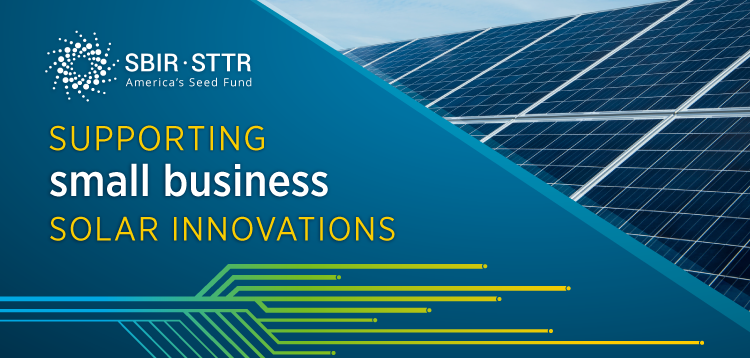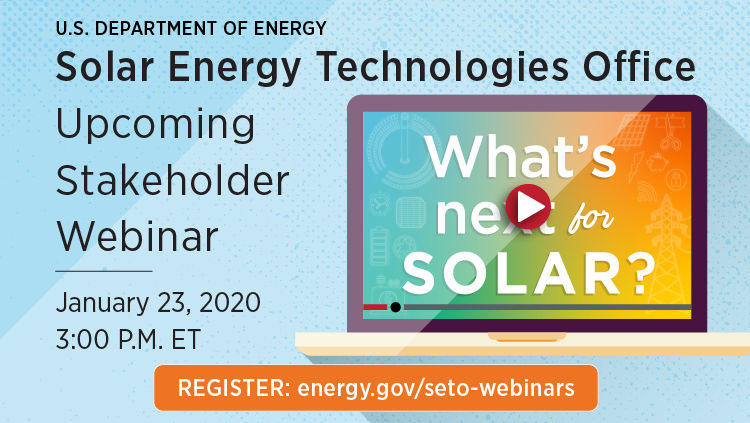Top News: Work at SETO; Collegiate Competition Finalists; Systems Integration Project Details
Want to work in solar? The Office of Energy Efficiency and Renewable Energy’s Solar Energy Technology Office (SETO) may have a place for you. It’s an opportunity to contribute to the office’s goals and also learn a lot, whether you’re interested in photovoltaic (PV) cells and their emerging technologies, inverters and grid services, or some current systems integration projects the office is funding. SETO supports small businesses, college students, and anyone who’s got a bright solar idea. Are you in?
These stories and more in this edition of the SETO Newsletter.
Apply to Work at SETO
The Oak Ridge Institute for Science and Education (ORISE) Science and Technology Policy Opportunity is seeking the next generation of technology leaders in solar energy to help advance SETO’s mission. This is a paid opportunity for recent graduates with a bachelor’s, master’s, and/or Ph.D. degree in quantitative fields and established professionals with relevant post-degree experience. Participants will help the solar office design initiatives that advance photovoltaic, concentrating solar-thermal power, and systems integration technologies, and support tech transfer, analysis, and soft-costs reduction activities. Learn more and apply by January 15.
The office is also in search of an engineer with U.S. grid experience to join the systems integration subprogram and a PV scientist to join the PV team and serve as a technical adviser. All positions are based in Washington, D.C. Throw your hat in the ring!
Photovoltaics on the Cellular Level
How do solar cells work? What are they made of? Why do we need different kinds, and what are those all about? Find the answers to these questions and more—about materials and structure, the importance of bandgap, and emerging technologies like perovskites and even quantum dots—in this new two-parter, PV Cells 101: A Primer on the Solar Photovoltaic Cell and Part 2: Solar Photovoltaic Cell Research Directions.
 New Year, New Funding for Small Businesses
On December 16, 2019, the Small Business Innovation Research (SBIR) and Small Business Technology Transfer (STTR) program announced the SBIR/STTR 2020 Phase I funding opportunity. Solar small businesses with big ideas to advance high-risk, innovative solar technologies with commercialization potential are encouraged to apply. If you missed the December 18 webinar discussing the two solar topics—one of which offers a chance to partner with the National Renewable Energy Laboratory—you can listen to a recording on our website.
Systems Integration Project Info? We Can ASSIST
In March, SETO awarded $36 million to 10 projects in the Advanced Systems Integration for Solar Technologies (ASSIST): Situational Awareness and Resilient Solutions for Critical Infrastructure funding program, and now you can learn about each project’s approach and goals. All of these efforts are working to improve situational awareness of solar energy systems, especially at critical infrastructure sites, make the grid more resilient to cyber and physical threats, and advance solar integration on the grid.
Grid Conjunction Functions
Sine waves injected into the electric grid. The quiet beauty of reactive power. The black start backup plan. These are things we think about when we work to bring more solar into the energy landscape. Check out SETO’s new Solar Integration: Inverters and Grid Services Basics page to find out why. After all, you can’t have a solar energy system without an inverter, and you can’t have a grid without services. You can go through life not knowing why, but why would you want to?
Finals Time for Collegiate Competition
This is not a test: The Solar District Cup finalists were announced December 12, 2019. Of the 61 participating teams from 52 institutions, 35 teams from 32 institutions are moving forward in their quest to reimagine and design energy systems for campuses and urban districts. Once they submit their project designs, they’ll present them to judges and industry at the Solar and Energy Storage Southeast conference in April. When the winners are announced, we’ll let you know, so stay tuned. Just another reason to look forward to spring….
 Coming Soon: SETO Stakeholder Webinar
It’s almost that time again: Join us January 23, 2019 at 3:00 p.m. ET for our next stakeholder webinar. The main topic? An overview of the projects selected through our FY2019 funding program. It’ll be a comprehensive discussion, since the projects span SETO’s portfolio, and we’ll be taking your questions at the end. Don’t miss it!
A Prize-Worthy Network of Pros
If you’ve been watching the evolution of the American-Made Solar Prize, you’re probably aware of the American-Made Network, a valuable resource available to all competitors—even those innovating beyond solar solutions. Anyone competing in an EERE prize competition has access to these industry partners, National Laboratories, and other parties across the country who have signed up to help shepherd renewable technology innovations to commercialization. Now you can learn more about the Network’s role in competitions in this blog post by EERE Assistant Secretary Daniel R Simmons.
|